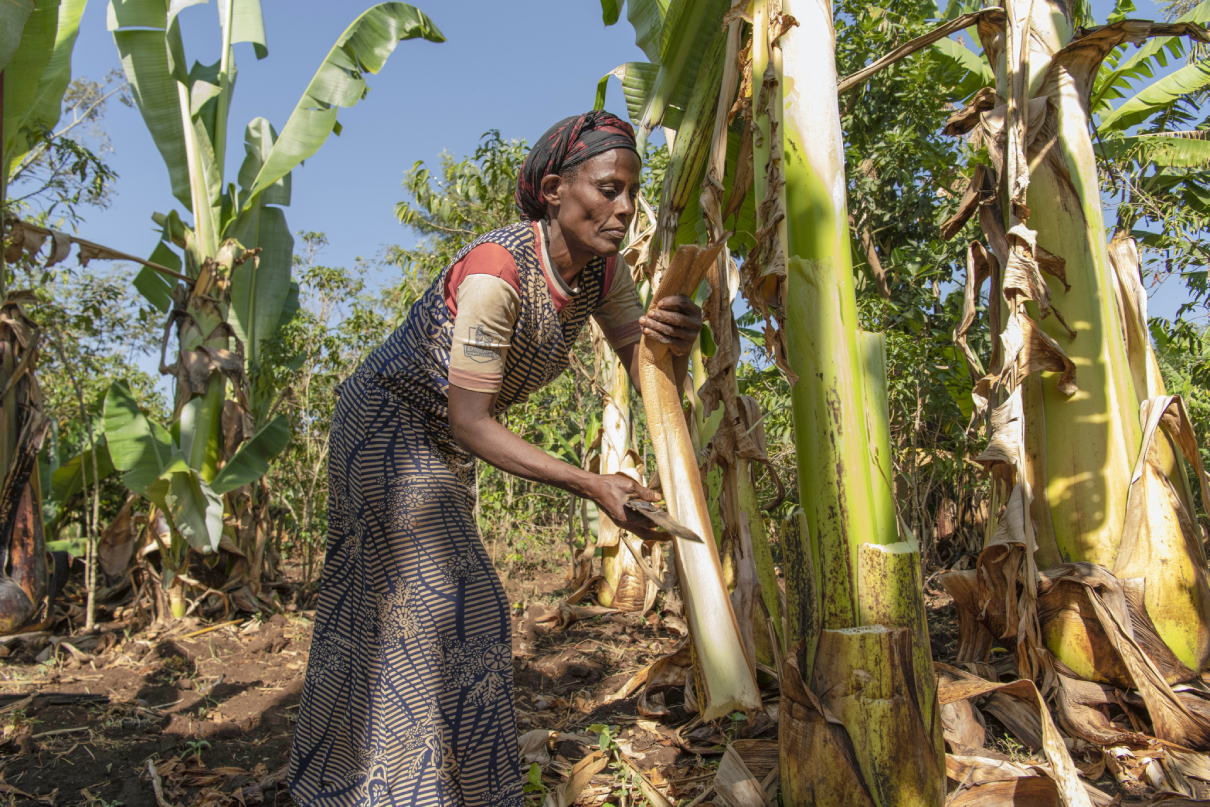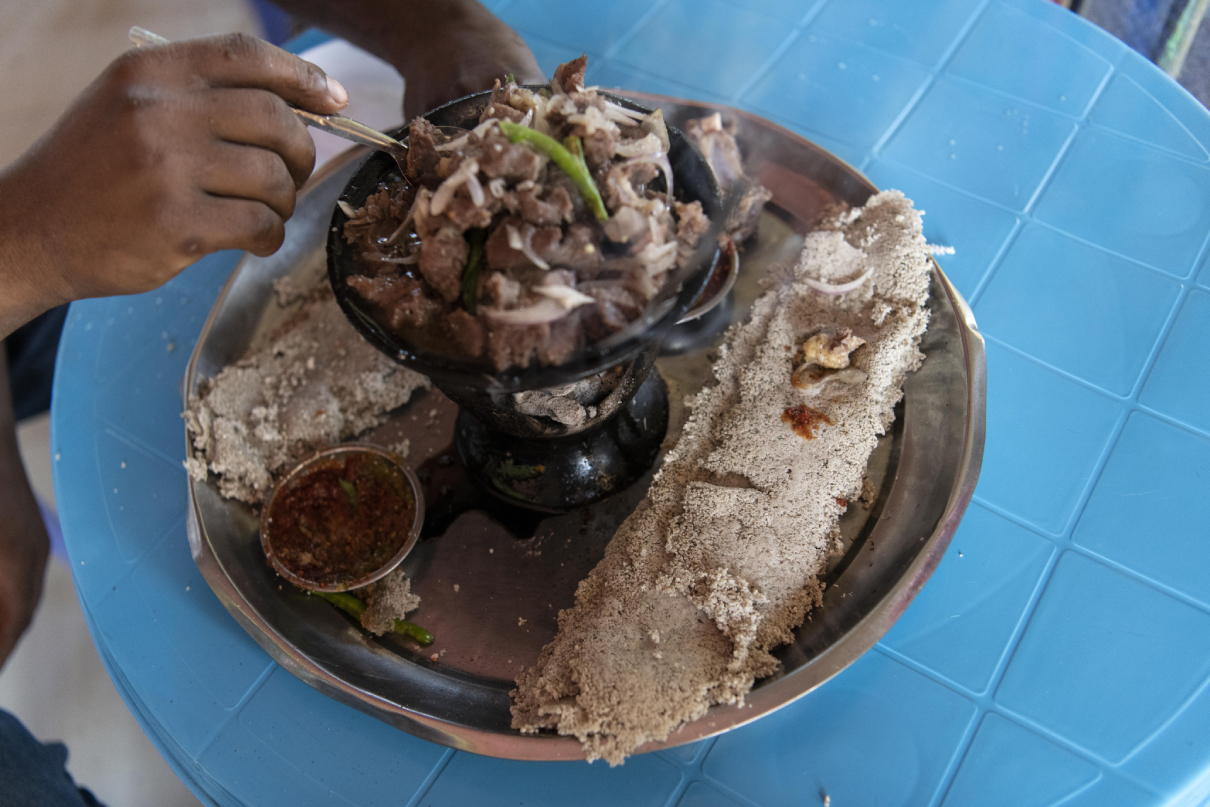- Although varieties of the plant are found in many sub-Saharan countries, only in Ethiopia has it been domesticated.
- Land scarcity means farmers are turning to growing more lucrative cash crops, such as the stimulant khat or maize, with the number of enset farms declining in recent decades.
- The plant is also threatened by blight, leading researchers to develop a genetically modified variety that’s now being tested — amid controversy — for disease resistance.
SIDAMA, Ethiopia — For Lidya Ashango and 14 million other Ethiopians, the false banana plant widely known as enset is a staple food and, on many occasions, a supplementary source of income. But it’s no longer easy to grow this crop in the southern part of the country, where land is scarce and plant disease is inevitable.
A mother of seven living in this southern town of Sidama, Ashango and her family have been growing, harvesting and processing enset as long as she can remember.
Men plant the crop, but the women do the time-consuming and laborious work of producing food from the crop. By the time a well-tended crop is ready to harvest, three to four years after planting, the woman goes to the farm with a machete and cuts the false stem to scrape and separate it into a starchy pulp and a fiber.

The pulp is covered with enset leaves and left in a pit to ferment for months before being used to make various bread and porridge dishes. Kocho, the fermented product to turn into bread, and bulla, the flour to be cooked into porridge, are among the dishes prepared by the women from the plant. The leaves are used for livestock feed and packaging.
Although enset varieties are known to be found in other countries in Africa such as Uganda, this cultivation and fermentation process is largely known only to Ethiopians with traditional indigenous knowledge. Gurage, Sidama, Gedeo and Hadiya are a few of the ethnic groups that grow and depend on this perennial crop.
Enset’s label as a tree against hunger was adopted in 1984, when the northern part of Ethiopia that’s mainly dependent upon cereals like teff was severely hit by drought and famine. Researchers note that the south, which relies on enset, saw no such tragedy; and also that the tree is relatively resistant to climate change and exists in hundreds of varieties.
Unlike other cereals, it can also be intercropped with coffee or other fruit-bearing trees, still providing a higher yield per unit area.
See related on enset in the region: Agroforestry ‘home gardens’ build community resilience in southern Ethiopia

However, despite enset’s popularity, rapid population growth in Ethiopia has put pressure on available land, and farmers seeking more income are turning toward cash crops like khat, a stimulant, and maize.
“Less land means less livestock and less manure for the plant,” said Beyene Teklu in an interview. Teklu has been researching farming systems in Ethiopia, especially enset, for the past six years.
According to a study he did on 240 farms in Sidama and Gedeo, khat-based farms grew by 21% between 1991 and 2013, whereas enset-based farming showed a decline of 13% during this period.

But the intensive production of cash crops like khat and maize can only be good for the first three or four years. After that, land that was left empty for several months after harvesting will be eroded and the nutrients gone, resulting in a very low yield the next harvest.
Teklu says this will in turn force youths to abandon the farms and leave for cities, which are growing increasingly crowded with jobseekers.
Beyond land scarcity, the other threat to enset is its high vulnerability to mealy bugs and diseases like bacteria wilt, which dry up its leaves and eventually kill the whole plant.

Recent reports by the U.S. Department of Agriculture show that Ethiopian researchers, in collaboration with the International Institute of Tropical Agriculture (IITA), have used genetic engineering to produce a modified enset that’s resistant to bacteria wilt.
However, scholars like Teshome Hunduma, a Ph.D. research fellow at the Norwegian University of Life Sciences, looks at the initiative with a critical eye.
In an article for the local news site Addis Standard in April, Hunduma said there are no independent studies that show improved yield, disease-resistance or socioeconomic benefits for smallholder farmers from the use of genetically modified crops. “An attempt to genetically modify and release enset for commercialization requires a high-level of precaution,” he wrote.
An orphan crop that’s been neglected by the government for several years, enset’s future lies in long-term strategies that apply beyond five or 10 years, according to experts like Tekle.
Banner image: Ashango’s brother-in-law, Dilke Didamo, 38, is portrayed at the family’s enset farm in Sidama, Ethiopia. Photo by Maheder Haileselassie Tadese.













